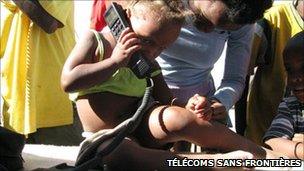How Disaster Relief 2.0 is saving lives in Haiti and beyond
- Published

Telecoms Sans Frontieres provided 765 hours of free communications to survivors
The way we react to natural disasters is changing.
When crisis hits, the basics are needed. Food, water, shelter and, almost as important, internet access.
It could be described as Disaster Relief 2.0 - the relief services mobilised by telecoms and social-networking.
Six months on from Haiti, the impact of successful social-networking went far beyond sharing news on Twitter. It played a vital role in knowing where to distribute aid, offering advice and reconnecting people.
None of which, however, could have been achieved without the efforts of communications experts deployed to the affected areas.
Non-government organisations such as Telecoms Sans Frontieres (TSF) specialise in re-connecting devastated, cut-off communities to the outside world just hours after tragedy hits. And, crucially, days before existing communication infrastructures can be restored.
60,000 connected
Monique Lanne-Petit, founder of TSF, was sent to Haiti soon after the earthquake struck. Immediately, she began the job of connecting Port-au-Prince to the outside world.
"The day after we arrived, we set up a satellite connection to the prime minister because they needed to contact and communicate," she explained.
"In Haiti, GSM connectivity was very poor. SMS worked but had uncertain reliability."
Many telecoms towers in Haiti had collapsed - crippling mobile and landline services. The fibre-optic cable connecting Haiti to the outside world had been severely damaged.
"In total we opened seven telecoms centres in Port-au-Prince. 10,000 families were connected. Considering an average of six persons per family, 60,000 people have been reached."
These connections proved to be life-saving.
TSF helped more than 100 aid organisations communicate, including the World Food Programme and Unicef. Over the course of six weeks, they say they offered 765 hours of communication to people in Haiti.
Those hours were put to good use as people used Twitter, Facebook and other sites to make pleas for help.
Missing person lists were set up online to help track down family members - reassuring people outside of Haiti as well as bringing together families separated in the disaster zone.
'Middle of nowhere'
Gabriela Alvarado faced a similar challenge when flying in to Sudan in the wake of catastrophic floods in 2007.
As an IT officer in the telecommunications division of the United Nations World Food Programme, she has had experience all over the world in a number of disaster zones and areas of conflict.
She says Sudan was one of the most challenging.
"We were asked to fly in with the logistics team. It was literally in the middle of nowhere.
"We came in with a small generator, we came in with the satellite systems, a couple of desktops systems to act as servers."
Within the next day and a half she had set up a mini-office - a place where she could make telephone calls, send e-mail and print documents.
"It just feels really good that because of something you're able to do you can set something up that actually serves a much bigger cause - and it's something that, on top of it, you enjoy."
Ms Alvarado cites her laptop as being the most important tool for her work. On it, not only does she have software that allows her to complete humanitarian tasks, but also reference material.
The laptop allows her to deal with varying degrees of safety and security in different regions, keeping checklists and safety guides with her - an amount of information that would be impractical to transport any other way.
"It's my off-site encyclopaedia. It has everything," she said.
More women
It is not just the equipment which is changing - the people doing the jobs have changed too.
Ms Lanne-Petit and Ms Alvarado are just two examples of women now pioneering in a male-dominated world.
"I would like to see more women in this field, because I think we do get discouraged," said Ms Alvarado.
After taking a course into safety issues relating specifically to female telecoms specialists in disaster areas, she is keen to help other women overcome their worries about getting into the same kind of work.
"It has helped me talk to other women that are in the IT field and have thought twice about going into emergencies.
"It is difficult, it's not an easy thing, but it's an amazing job. It's a greatly rewarding thing that you are becoming part of something that helps save lives, and helps improve the life of other people.
"If I can help more women get into the job, I would be honoured if I was considered their role model."